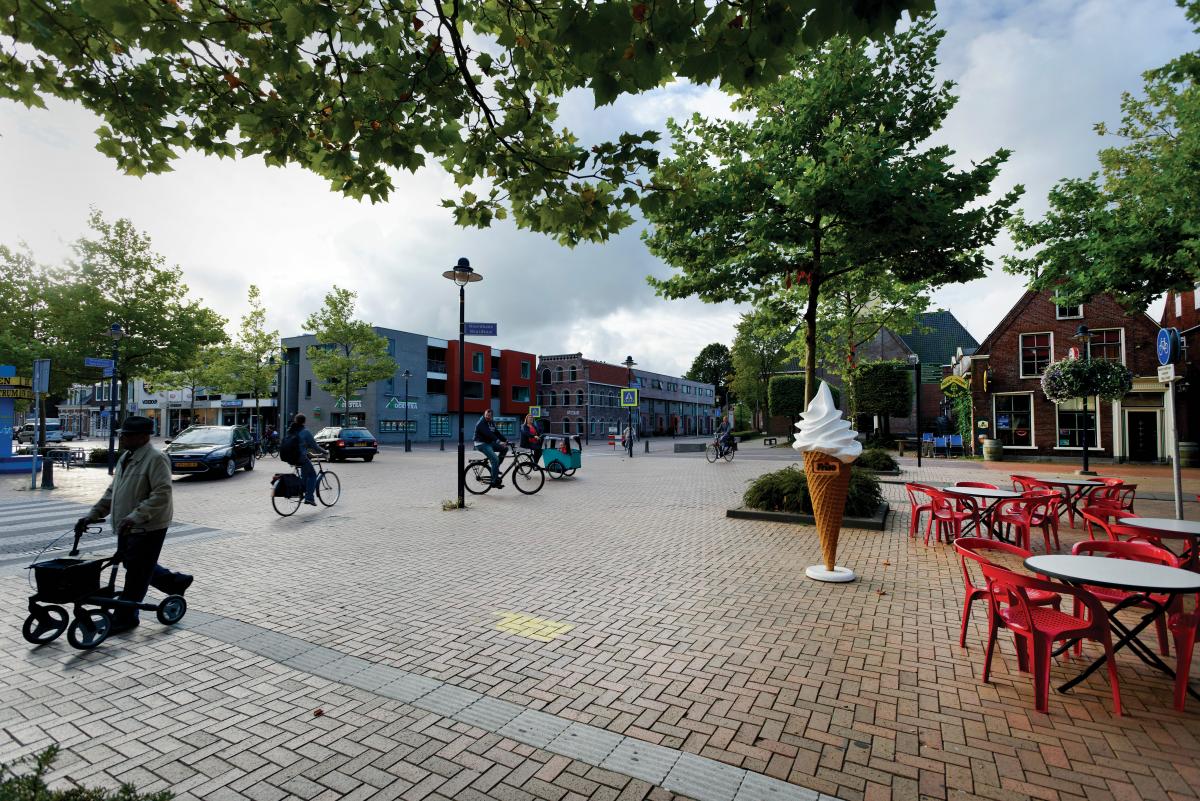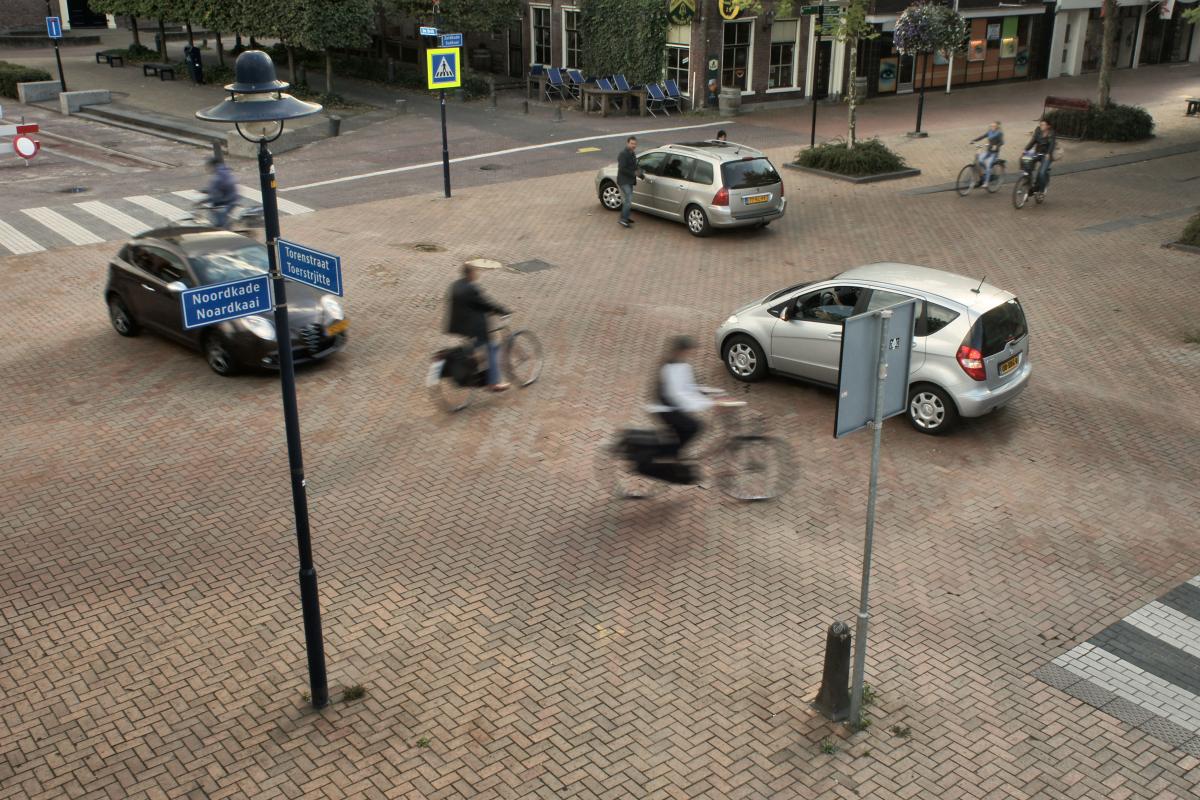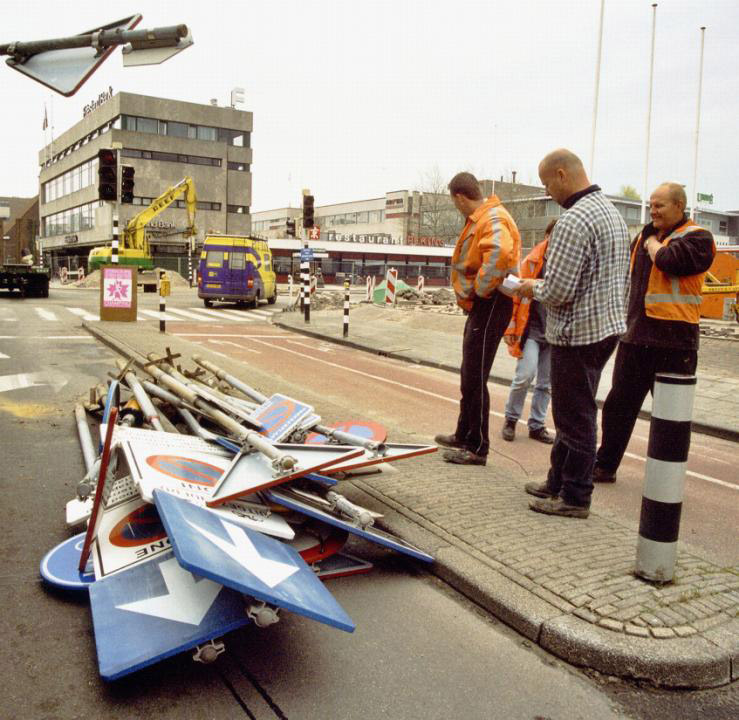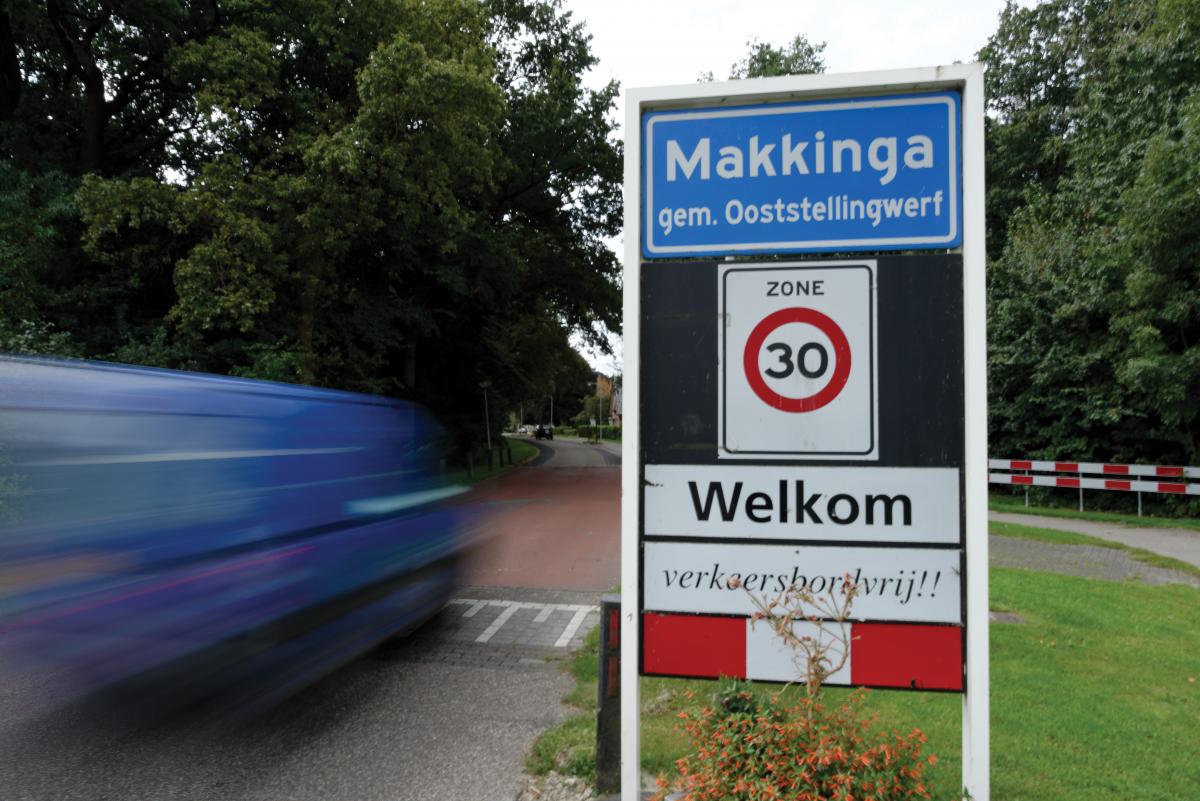Space for People, Not for Cars
Hans Monderman, father of the Shared Space movement, argued that reducing traffic regulations can improve road safety. Statistics prove him right, but not everybody is convinced.
Cover photo: In the town of Oosterwolde (10,000 inhabitants), the Oost road junction has been converted into a shared space where drivers, cyclists and pedestrians mix together, negotiating right of way by means of informal social rules rather than by defined traffic rules. Kerbs were removed so that there is no clear physical demarcation between the pavement and the rest of the street. When people feel that a situation is potentially unsafe, they stay alert, reduce speed and cause fewer accidents. (Photo: Peter Biľak)
Away with zebra crossings, speed bumps, traffic lights, safety islands, and even road signs! Traffic engineer Hans Monderman (1945–2008) argued for fewer traffic laws and more personal responsibility as the key to increasing road safety and quality of life in urban areas. It is a philosophy that has been dubbed ‘Shared Space’, a name under which similar projects are being established all over the world.
In the past, anyone walking from Leeuwarden’s central railway station to the city centre would have passed through a strictly regimented traffic zone consisting, like so many others, of a paved road on which all motorised traffic (including a busy bus route) raced by, a separate bike path, a zebra crossing and a pavement. Now, after years of indecision, the municipality wants to recast this once characterless square, the Wilhelminaplein, as the city of Leeuwarden’s new ‘living room’. And the transformation is finally becoming reality: the square has been largely redeveloped in accordance with the philosophy of Hans Monderman, a traffic engineer and native son of Leeuwarden. All road signs, speed bumps and pavement strips have been eliminated, with the paving of the square and the road combined into a single unit. The square (where the weekly farmers’ market is held, and which can easily accommodate the occasional music festival) is distinguished from the road only by the slightly different shade of grey of the paving. New street furniture and features have been added, such as wooden benches and trees. The stately old court building now looks directly onto the new Fries Museum and, to the left, onto a new row of shops, cafe terraces, and restaurants, and the apartments above them. On the vast square in between, cyclists, motorists, and pedestrians can be seen participating as equals in a harmonious urban flow. It is, at first glance, perhaps a curious sight: a few pedestrians walk blithely in the middle of the road, suddenly meandering across it at an angle as there are no zebra crossings to lead them any other way; as they do, a car manoeuvres around them, calmly and vigilantly. The only road sign to be seen, reading ‘excepting bicycles and mopeds’, is probably something that Monderman himself would have left out, but he would no doubt have been pleased to be able to look upon this, the successfully redesigned Wilhelminaplein.
Monderman’s theory was that increasing traffic regulations reduces personal responsibility, the need for drivers and pedestrians to pay attention to what is happening around them.

Drachten, a Dutch town in the northern province of Friesland, with a population of about 45,000, is a showcase for the Shared Space movement, with most city crossings redesigned by Hans Monderman. De Kaden, a central crossroad junction in a shopping centre of Drachten, features no traffic signals and no traffic being given the right of way. In the seven years before the redesign of the junction 30 collisions were reported, including four involving injury. In the two years following the scheme there were only four collisions, and no injuries were recorded. (Photo: Peter Biľak)

(Photo by Raban Haaijk)
You seem to enjoy a good story
Sign up to our infrequent mailing to get more stories directly to your mailbox.Hans Monderman, a traffic engineer, or perhaps more aptly, a traffic philosopher, did not believe in traffic laws as we know them. After completing his studies, he designed roads in his native Friesland and drew on his experiences as a driving instructor to understand how road accidents occur. ‘All those road signs,’ he once said, ‘they all essentially tell you the same thing: just drive, don’t worry, drive as fast as you want, no reason to pay attention to what’s going on around you. And that’s a dangerous message.’ It was from this concept that Monderman began developing his new vision of traffic safety in the early 1990s. Ultimately his concept became known as Shared Space, and it elevated Monderman to national and international prominence. In 2004 his philosophy was developed into the four-year European Shared Space project. Monderman headed the project’s teams of experts, both in the Netherlands and at the international level.
He was a long-time advocate of reducing rules and increasing personal responsibility. Road signs, speed bumps, traffic lights and zebra crossings all diminish that responsibility, shifting the emphasis of a space to the technical and the legal. This leaves little of the quality and the essence of the place you move through; it is then no longer a place where you can slow down, stay, breathe, relax, meet. His answer was to do away with them. ‘The goal is to create a high-quality environment offering equally high quality of life, serving people, not traffic,’ explains traffic engineer Sjoerd Nota of the firm Ruimte voor Iedereen (Space for All), also affiliated with the Shared Space Knowledge Centre at the University of Applied Sciences in Leeuwarden where the faculty of Civil Engineering, Civil Technology and Mobility initiates and performs research and offers advice, and which also implemented a successful Shared Space project, completed some three years ago, right in front of the university. In this project, a typical busy access road became a pleasant campus square where buses, bicycles, pedestrians and motorists coexist in harmony.
‘The trend is that the traffic engineer with the rule book under his arm is no longer claiming the exclusive right to redesign the city centre space, but is choosing an approach that covers the full spectrum of interests,’ says Nota. He himself also works in Monderman-style Shared Space projects with governmental agencies, educational institutions, consulting firms, architects, local authorities, psychologists, social geographers and residents. ‘In his theory, road users are encouraged to pay more attention to each other,’ Nota explains. Monderman believed that as soon as you stop telling people what they can and can’t do (traffic behaviour), they instinctively learn what they should do (social behaviour). ‘Traffic becomes safer, and the severity of accidents decreases, once road supremacy is no longer claimed by the motorist,’ says Nota. ‘When the road belongs to everyone, people learn to pay attention to each other, and motorised traffic slows down all by itself. Speeds actually go down by an average of 40%.’
Objectively, statistics show that Shared Space design increases traffic safety. Subjectively, residents of Shared Space areas report feeling less safe.

Shared Space is an urban design concept that promotes the reduction of barriers between pedestrians and vehicles, and the elimination of traffic signs and signals. It was pioneered by the late Dutch traffic engineer Hans Monderman, who spent much of his career implementing Shared Space schemes in Friesland, the northern province of the Netherlands. To date, the Shared Space concept has been used in Germany, the United Kingdom, Scandinavia, New Zealand and Australia. (Photo: Municipality Smallingerland)
Monderman’s philosophy has now been implemented in some 150 locations in the Dutch provinces of Friesland, Groningen and Drenthe. And Shared Space has also begun springing up elsewhere in the country. In other countries such as Denmark, Sweden, Austria, Spain, Belgium and Germany, Monderman’s vision has been embraced widely, as it has in the United Kingdom, with perhaps the most highly publicised Shared Space project the redevelopment of Kensington High Street in London. Then there is New York, where Monderman gave impassioned lectures on his theories of traffic. In 2005, he took New York Times reporter Sarah Lyall on a tour of Drachten, where Monderman launched one of his first and still best-known projects, the Laweiplein and the Drift/De Kaden junction. Lyall described this city centre junction as an anarchic jungle, but did immediately note that no one hooted their horns or yelled at Monderman when he simply strolled out onto the square into traffic, asking rhetorically, ‘Who has the right of way?’ He didn’t actually care. ‘People here have to find their own way, negotiate for themselves, use their own brains.’
In 2001, the Laweiplein and De Kaden were essentially the birthplace of Shared Space in Friesland. Monderman convinced policy-makers, local authorities and residents to make De Kaden qualitatively more pleasant for all road users by taking away traffic lights, minimising the rules, lowering speeds and promoting traffic flow—all at a complicated junction at which a bus route and motorised traffic (up to 17,000 vehicles per day) enter the junction from three directions, with cyclists and pedestrians coming from four directions. The whole space became a cobblestoned public square with no pavements. But the number of accidents did not decline, Nota’s research shows, primarily because the surrounding area and connecting routes were still under very traditional rules of the road. It was then that the local authorities began extending the approach to the surrounding area.
Even more motorised traffic goes through the Laweiplein, some 22,000 vehicles a day. There, the Shared Space approach resulted in a roundabout with a green patch at its centre. The only road signs here seem to be light poles and the yield signs on the road. The results are impressive. Comparison of the period 2000–2008 and the period before the redesign shows that the number of accidents as well as the number of serious accidents has decreased by 50%. The flow of traffic has greatly improved.
The master plan for the redevelopment of the historic Sneek city centre involved the addition of a high-quality shopping and recreational area at the Prins Hendrikkade and Vismarkt junction. It created more room for pedestrians, cyclists, and those travelling by water, while rerouting traffic and improving traffic flow. Users nonetheless felt that the area had become less safe; this tension stems from their unfamiliarity with the concept, and is a commonly cited phenomenon in its application.

The only traffic sign in the village of Makkinga says ‘Verkeersbordvrij’ which translates as ‘free of traffic signs’. Makkinga was the first community to introduce the concept of Shared Space in 1998, and probably the only place in the world with a total absence of traffic signs, road markings, parking meters and pedestrian crossings. (Photo: Peter Biľak)
Monderman’s favourite road safety test: walking backwards across a busy crossing with his eyes closed.
Not everyone, it seems, is eager to embrace Monderman’s philosophy. As the saying goes, a prophet is without honour in his own country. Though much in demand as a pioneering expert in the field for over 25 years, at home Monderman often had the sense of being seen as eccentric or simply a troublemaker. The effects of Shared Space are still hotly debated in the field. Is it pie-in-the-sky, or does it really work? Local authorities worry about liability issues and are unwilling to be left with the feeling that they have not done everything possible to make their cities safe. The Directorate-General for Public Works is hesitant. Some projects, like the ones in Drachten and Haren, have been reversed in the face of political pressure and negative public image, to be replaced by the old familiar zebra crossings—because the residents subjectively report feeling less safe in the absence of traffic lights or crossings, even though objective research shows that removing them improves safety. In Haren, the number of accidents fell by 46%; the number of crash-related injuries by as much as 83%.
Whatever the case, the fact that more places in this country and abroad are developing Shared Space projects is a positive sign. No doubt Monderman would have liked to have experienced them for himself while performing his favourite traffic safety test: walking backwards with his eyes shut across a busy crossing. And no, he didn’t die in the street, but in his bed.

